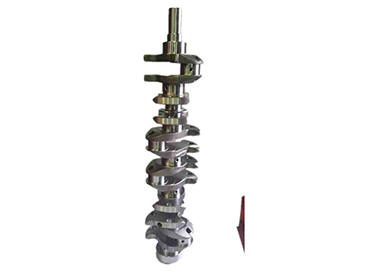Jul. 13, 2020
6. Crankshaft for trucks journal wear
Worn crankshaft journals have the same effect on engine oil as bearing wear. When the wear is round, the gap between them and the round bearing will be uneven. The size of the gap between the out-of-round crankshaft journal and the bearing changes during rotational motion, and more oil is thrown away. Out-of-round bearings need to be reground and use smaller size bearings to match them.
7. Cylinder liner grinds into a cone or out of round
For cylinder sleeves ground to a slight taper and out of round (cylindricity and concentricity decrease), the oil consumption can be controlled by the piston and the piston ring. However, as the taper and out-of-roundness of the cylinder liner continue to increase, it becomes increasingly difficult to control oil consumption. This is the result of a combination of many factors. As the gap between the piston and the cylinder liner increases, it will cause the piston to oscillate during operation; this momentary tilting oscillation will cause excessive oil to stay on the side of the piston, and the same situation occurs on the piston ring. In this way, as the piston continues to oscillate back and forth, some oil will enter the combustion chamber. The piston completes two strokes, one up and one down, for each revolution of the crankshaft. When the engine is running at 3000 rpm (approximately 60 mph), the piston ring running in the deformed cylinder liner will withstand 6000 changes/min in size and shape changes. As a result, under high-speed operation, the piston ring may not be able to adjust the fit-gap between itself and the cylinder liner in time (especially when running to the worn part of the cylinder liner, causing the fit-gap to be too large). Therefore, as long as the above situation occurs, the engine oil consumption will be too high.

Crankshaft For Trucks
8. Deformation of cylinder liner
Different from the rounding of the cylinder liner due to wear mentioned in 7, there are other reasons, such as uneven heating or uneven tightening of the cylinder head bolts, etc., which may cause the distortion of the cylinder liner and cause the piston ring to fail Forming a proper fit contact with the surface of the cylinder liner, the oil scraping function is reduced; as a result, too much oil remains locally, and eventually enters the combustion chamber and is burned, resulting in an increase in oil consumption.
9. "PCV" Crankcase positive pressure ventilation valve or pipe is blocked
The main role of PVC (Crankcase Positive Pressure Ventilation) is to recycle the mixed gas that has entered the crankcase from the engine combustion chamber, reducing the content of unburned hydrocarbons. The mixed gas is a mixture of air, fuel, and combustion exhaust gas. During the power stroke, due to high pressure, it enters the crankcase through the gap between the piston/piston ring and the cylinder liner. PVC systems usually have a pipe that leads from the crankcase to the carburetor or intake manifold. The vacuum generated by the intake air in the engine intake manifold sucks the mixed blow-by gas from the crankcase, enters the combustion chamber, and recycles it again. PVC (Crankcase Positive Pressure Ventilation) valves may be blocked by sludge, paint film, or other impurities in the mixed blow-by gas. This will cause the engine oil to deteriorate and generate excessive deposits. As a result, the piston ring (oil ring) becomes blocked, the oil consumption increases and the piston ring wears prematurely; the crankcase pressure increases, resulting in the failure of the OEM AUDI crankshafts seal ring, The engine oil oozes and deteriorates the engine operating conditions.
Navigation
Name: Carrie Zhou
Tel: +023-68886580
WeChat: 0086-13650592877
E-mail: carrie@autopartstf-ws.com
Skype: transfortune
WhatsApp: +86 136 5059 2877
Homepage: www.autopartstf-ws.com